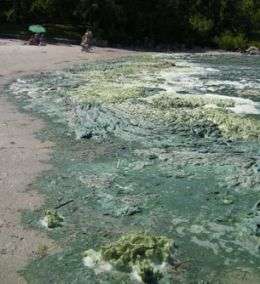Controlling nitrogen pollution will not stop toxic algae blooms, says research

Research from the University of Alberta has confirmed that algae blooms, which can poison lakes and kill fish, can be controlled by limiting phosphorus.
After completing one of the longest running experiments ever done on a lake, researchers from the U of A, the University of Minnesota and the Freshwater Institute, say nitrogen control won't be effective in controlling the growth of blue-green algae and, in fact, may actually increase the problem.
"What we found goes against the practices of the European Union and many scientists around the world. Controlling nitrogen does not correct the polluted lakes, and in fact, may actually aggravate the problem and make it worse," said David Schindler, professor of ecology at the U of A, and one of the leading water researchers in the world.
The dramatic rise in cultural eutrophication-the addition of nutrients to a body of water due to human activity-has resulted from increased deposits of nutrients to lakes, largely from human sewage and agricultural wastes. Scientists around the world have been looking at limiting nitrogen as a way to control the algae outbreaks that result from this over fertilization, but the new research suggests that might not be the best way to go.
The trick is to focus regulation on phosphorus, says Schindler. "Of the three major elements that algae needs, phosphorus is the only one that it can't get directly from the atmosphere. There's a little bit in geology and little bit in rainfall, but not much. It's basically a rockbound element."
For 37 years, the researchers have looked at Lake 227, a small lake in the Canadian Shield at the Experimental Lakes Area (ELA) in Ontario, and examined the best ways to control the cultural eutrophication process by varying the levels of phosphorous and nitrogen added to the lake.
"We have kept that lake in a state of eutrophication, even though we stopped adding nitrogen 16 years ago because we couldn't afford it," said Schindler. "The lake has shown absolutely no decline in algal blooms without the added nitrogen."
"These algae blooms are a phenomenon of the last 100 years and largely the last 50 years," said Schindler. "Algae are plants, and we all know what happens when you apply phosphorus and nitrogen to plants in our yards. And while we like lush plants in our years, we don't like it in the water."
A previous study, entitled, "A Survey of the State of the World's Lakes," found that the cultural eutrophication of lakes has had a global effect. The percentage of lakes with cultural eutrophication on each were shown in the study: Asia has 54 per cent; Europe has 53 per cent; North America has 48 per cent; South America has 41 per cent, and Africa has 28 per cent.
"The damage to these lakes is a major concern for virtually every continent," said Schindler.
The impact on human society is immense he says, as cultural eutrophication severely reduces water quality, which not only kills and contaminates fish, shellfish and other animals, but also can become a health-related problem in humans once it begins to interfere with drinking water treatment.
This study appears in the journal Proceedings of the National Academy of Sciences.
Source: University of Alberta




















